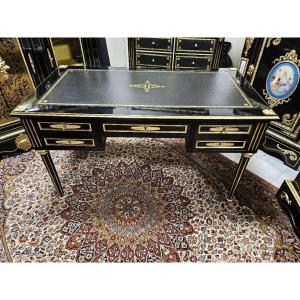François Honoré Jacob (1770-1841) - Empire period mahogany Tronchin table circa 1810
Commissioned architect's table or Tronchin-style table in mahogany veneer and flamed Cuban mahogany veneer, opening with a drawer at the waist revealing a writing desk. Two side pulls, movable rack top upholstered in superb light-blue leather with gold leaf decoration, tapered legs terminating in ormolu sabots and castors.
Very fine French Empire period work stamped Jacob D Rue Meslée for François Honoré Jacob (1170-1841) and Château mark.
Sizes: H 30.70 Inches. - W 35.43 Inches. - D 20.47 Inches.
In very good condition, varnished in our workshops.
Biography:
François-Honoré-Georges Jacob-Desmalter (1770-1841) was the most successful Parisian cabinetmaker between 1796 and 1825.
Son of Georges Jacob, who designed the Louis XVI and Directoire styles, he joined forces in 1796 with his brother Georges Jacob Fils to create Jacob Frères on Rue Meslée. His father had benefited from commissions from the royal family under the Ancien Régime, and the two brothers took on commissions from the imperial family.
Using sketches by painter Jacques-Louis David and ornamentalists Percier and Fontaine, the brothers created furniture inspired by Greco-Roman antiquity to launch the Empire style.
Their style is characterized by high-quality design, clean lines, original shapes, and the use of chased gilded bronzes (created by Pierre-Philippe Thomire). For joinery, he used mahogany, gilded wood, and lacquered wood, with occasional inlays of ebony and indigenous woods such as maple and yew.
For Empress Josephine, they delivered furniture to the Château de Malmaison, as well as to the Palais Rohan in Strasbourg, between 1807 and 1809, for the so-called “Napoleon I bedroom”. They work at the Château de Compiègne. They delivered the King of Rome's imposing cradle and Empress Marie-Louise's precious jewelry cabinet, based on designs by Percier and Fontaine. They were also responsible for the Salon d'Argent at the Élysée Palace.
Highly dependent on imperial orders, their workshop, which employed over three hundred workers, went bankrupt in 1813 when the First Empire's finances made it impossible to meet its debts. Jacob-Desmalter, however, managed to revive his business and, after the fall of the Empire, returned to his father's Bourbon clientele to create Restoration-style furniture. His son, Georges Alphonse (1799-1870), succeeded him in 1825.
He is buried in the Père-Lachaise cemetery (15th division).
The Tronchin table:
The Tronchin table is a late 18th-century table that appeared during the reign of Louis XVI. It takes its name from a Genevan physician, Théodore Tronchin (1709-1781), who published work at the time on bone diseases linked to poor posture at the work table, and on the advantages of creating a table with a tilting desk to keep the back straight and avoid any deformity or pain, whether working seated or standing. The innovation of this 18th-century table comes from a mechanism concealed in the thickness of the belt that raises the tabletop to the desired height.
The tabletop, which could be solid or fitted with a leather-covered lectern, can be tilted to the desired angle using a notched lectern and raised using a set of two or four racks concealed inside the legs.






























 Le Magazine de PROANTIC
Le Magazine de PROANTIC TRÉSORS Magazine
TRÉSORS Magazine Rivista Artiquariato
Rivista Artiquariato
